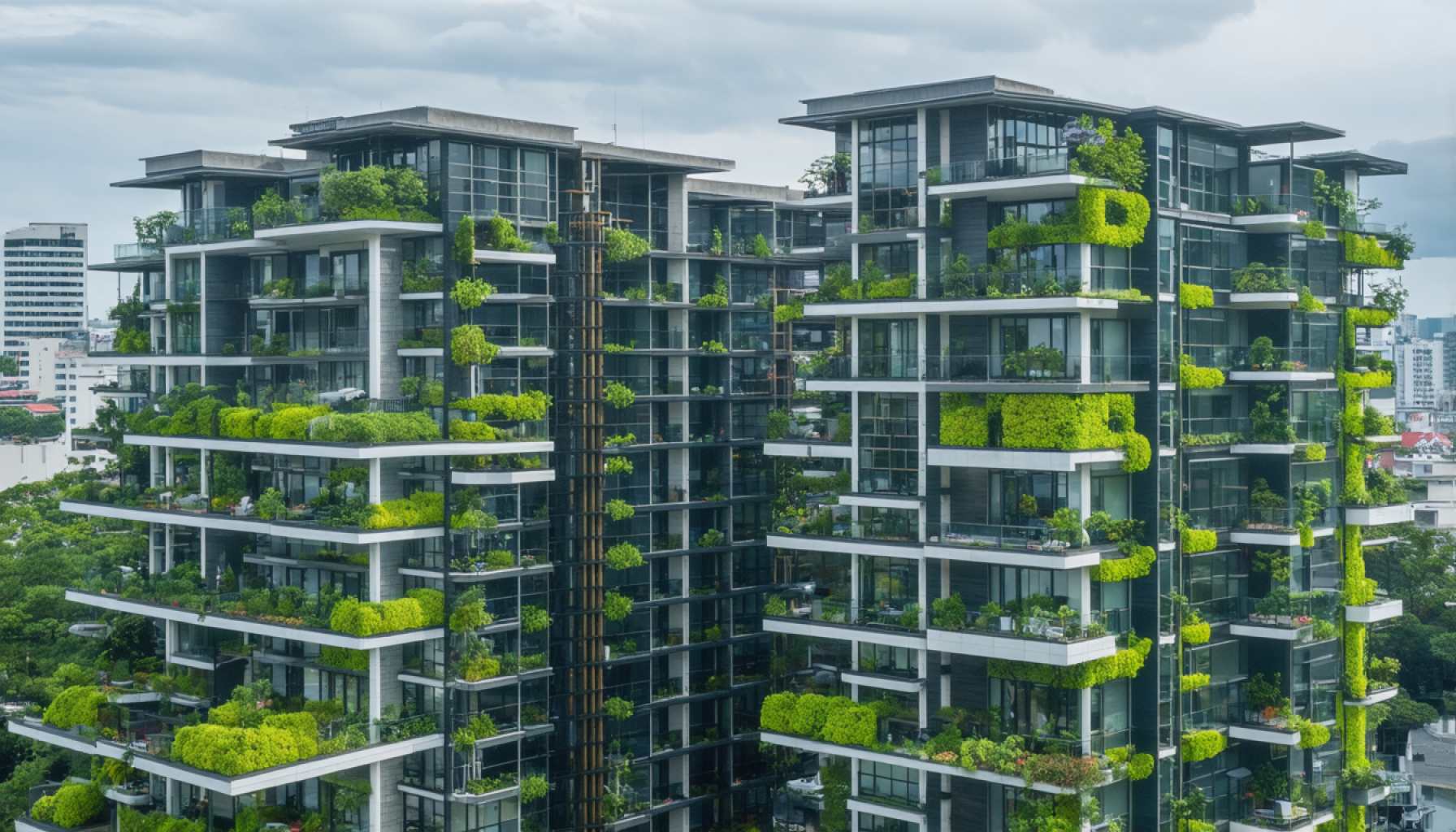- Laurel Court Hanazono Station Gate in Higashi-Osaka exemplifies Japan’s push for a sustainable future through modern eco-technology and EV infrastructure.
- By January 2025, each of the 69 units will feature Ubiden’s WeCharge smart outlets, simplifying electric vehicle charging for residents.
- The project supports Japan’s goal for a full transition to electric and hybrid vehicles by 2035, in line with government guidelines for extensive EV charging stations.
- Ubiden focuses on energy efficiency and cost-effectiveness, reducing electricity costs through balanced power distribution.
- The collaboration between Ubiden and real estate enterprises enhances sustainable living, promoting ecological awareness among residents.
- Under Nobuo Yamaguchi, Ubiden aims to redefine responsible living through innovative energy solutions.
- Laurel Court serves as a model for future residential projects, inviting global urban landscapes to embrace sustainable living.
Amid the bustling avenues of Higashi-Osaka, a quiet revolution unfolds. At the heart of this transformation is the “Laurel Court Hanazono Station Gate,” a sleek new condominium complex that embodies Japan’s ambitious stride toward a sustainable future. The building, with its clean lines and modern architecture, offers more than just luxury living; it promises a commitment to cutting-edge eco-technology, primarily through the integration of EV charging solutions provided by the innovative company, Ubiden.
Flash forward to January 2025, and the complex sits anchored in its commitment to sustainability. As urban environments grow denser and the global call for carbon neutrality intensifies, the deployment of electric vehicle (EV) infrastructure becomes more imperative. This is the essence of the Japanese government’s ambitious goal: achieving a 100% transition to electric and hybrid vehicles by 2035.
Here, the focus isn’t merely on aesthetics but on creating a seamless blend of comfort and environmental responsibility. Each of the 69 individual units benefits from Ubiden’s WeCharge smart outlets, a thoughtful inclusion ensuring residents can effortlessly charge their electric vehicles at any time. This innovation mirrors the autonomy of private home setups and eliminates the long waits typical in conventional shared charging systems.
The initiative aligns closely with the guidelines set out by Japan’s Ministry of Economy, Trade, and Industry, which advocates for the installation of up to 200,000 charging stations in communal living and parking complexes by the decade’s end. By marrying functionality with foresight, Laurel Court emerges as a model for future residential projects nationwide.
What sets Ubiden apart is their philosophy of intertwining energy efficiency with cutting-edge technology, delivering cost-effective solutions that minimize both the environmental footprint and the strain on residents’ wallets. The simple yet smart setup of their charging system deftly balances power distribution, reducing peak demand and leading to lower electricity costs while maintaining system integrity across the condominium’s parking facilities.
Laurel Court’s progressive stance reflects a broader push towards sustainable urban living in the region. The collaborative effort between Ubiden and real estate enterprises not only augments residents’ quality of life but also ignites a broader ripple effect — enhancing ecological awareness and fostering a community-wide ethic of sustainability.
For Ubiden, this partnership is not simply a business endeavor but a testament to their commitment to redefining what it means to live responsibly in the modern age. Under the leadership of Nobuo Yamaguchi, the company furthers its pioneering mission to “define the future of electricity” — a vision where energy is harnessed seamlessly and responsibly, underscoring the potential for technology to reshape humanity’s ecological footprint.
Through ventures like Laurel Court, Japan sets a precedent; it’s an invitation to envision and participate in communities where environmental stewardship and modern sophistication coexist. The landscape of Japan is steadily altering, brick by brick and charge by charge, signalling a sustainable shift that might just pave the way for cities worldwide to follow.
Revolutionizing Urban Living: How Laurel Court Hanazono Station Gate is Leading a Sustainable Shift in Japan
The unveiling of Laurel Court Hanazono Station Gate is more than just the introduction of a luxury condominium; it’s a landmark in Japan’s journey towards a sustainable and eco-friendly future. Situated in the heart of Higashi-Osaka, this groundbreaking complex melds modern architecture with cutting-edge environmental technology. Its foundation is steeped in a commitment to sustainability, particularly through its state-of-the-art integration of electric vehicle (EV) infrastructure provided by Ubiden.
Key Features and Technological Innovations
1. Smart EV Charging Solutions: Each of the 69 units is equipped with Ubiden’s WeCharge smart outlets. This ensures residents have access to immediate and hassle-free electric vehicle charging, replicating the convenience of personal home setups without the common limitations of shared charging facilities.
2. Eco-Friendly Design: The architecture is more than sleek aesthetics; it’s designed for energy efficiency. The complex employs advanced insulation and window technology to lower energy consumption, aiding in reducing both energy costs and the carbon footprint.
3. Grid-Friendly Systems: Ubiden has implemented a smart balancing system that manages energy distribution efficiently. By reducing peak electricity demand, this not only cuts down on power costs but also stabilizes grid integrity for the entire complex.
Real-World Applications and Case Scenarios
– Enhanced Resident Experience: The absence of long waits for charging not only saves time for residents but enhances their experience of modern, sustainable living. This approach mirrors global ideals for smart urban living, paving the way for future city planning.
– Community-Wide Impact: This initiative fosters a community-centric ethos around sustainability, where shared resources and energy-saving systems offer collective benefits, fostering a sense of shared responsibility among residents.
Market Trends and Industry Implications
– A Growing EV Market: Japan is on track for a complete transition to electric and hybrid vehicles by 2035. Developments like Laurel Court are critical in supporting this transition, making them attractive blueprints for new constructions worldwide.
– Rise in Eco-Conscious Architecture: The integration of sustainability in construction is a rising trend, not just in Japan but globally. Building designs that integrate smart technology solutions are expected to become standard practice.
Addressing Challenges and Providing Solutions
1. Cost Efficiency: While the initial investment in this technology is high, the reduction in energy costs over time coupled with government incentives for eco-friendly buildings can offset expenses significantly.
2. Scalability: Experts suggest careful planning in electrical grid support and infrastructure scalability to manage future expansions and increased electricity demands as EV adoption rises.
Insights and Future Predictions
– Expanded Infrastructure: As demand for EVs grows, so will the need for reliable infrastructure. Innovations like Ubiden’s will likely become more prevalent, encouraging faster adoption of EVs.
– Policy Support: Government policies, like those from Japan’s Ministry of Economy, Trade, and Industry, play a crucial role in incentivizing sustainable developments. This reflects a global trend where governments are driving eco-friendly initiatives.
Actionable Recommendations
– Invest in Smart Technology: For developers, investing in sustainable technology like smart EV charging systems and energy-efficient building materials is crucial for future-proofing residential developments.
– Embrace Community-Based Initiatives: Encouraging community participation in sustainability programs can enhance resident satisfaction and increase the perceived value of living in eco-friendly environments.
Conclusion
Laurel Court Hanazono Station Gate serves as a beacon for sustainable urban development, showcasing how luxury and responsibility can coalesce. As cities worldwide look towards greener futures, embracing such sustainable practices will be key to meeting global environmental goals effectively.
For more information on sustainable living initiatives and technological innovations, visit Ubiden or explore Japan’s green building trends at Japan’s Ministry of Economy, Trade and Industry.












